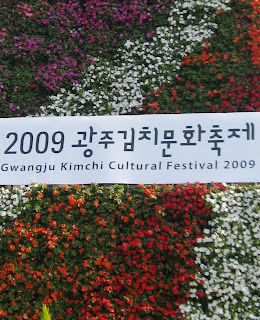 What a Glorious Holiday!
What a Glorious Holiday!Monday, November 30, 2009
Happy Thanksgiving!
 What a Glorious Holiday!
What a Glorious Holiday!Monday, November 16, 2009
DMZ Tour: Camp Bonifas

We need to be thankful for the freedom we have to contact our loved ones. Many individuals were never allowed to see their relations again after the Korean split at the 38th parallel. There are stories of husbands leaving their wives and family in search of resources down south that were never able to see them again. Families became enemies with the split and many North Koreans starved and suffered while their relations down south couldn't do anything about it. Some have mangaed to escape out of North Korea, but the government punishes and starves families of individuals who leave. There has been attempts to reunite families. Our tour guide told us a story of a ninety year old mother from South Korea reuniting with her seventy-five year old daughter from North Korea. These reunions don't last long before the individuals have to go back. It's hard to imagine how emotional this experience must be for that families that find each other.
They say that the reunification process has already begun here in Korea, but it's going to be a slow movement with many hurtles. I heard that today, one of seven people in South Korea still have relations in the North. Yet, with the seperation, the cultures have become so different.
Although people in the North, live in such poverty, their military is actually larger than in South Korea. North Koreans are forced to be in the military service for eight years, but they don't have the resources or money to finance an invasion of South Korea.
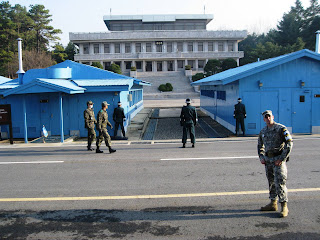 Camp Bonifas. Supposedly, we were being watched on North Korean cameras here hence the reasons for our strict dress code. To the right is our tour guide, a friendly US soldier from Missouri.
Camp Bonifas. Supposedly, we were being watched on North Korean cameras here hence the reasons for our strict dress code. To the right is our tour guide, a friendly US soldier from Missouri.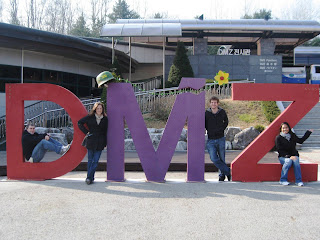 Having some fun with Andrew, Chris, and Christina.
Having some fun with Andrew, Chris, and Christina. 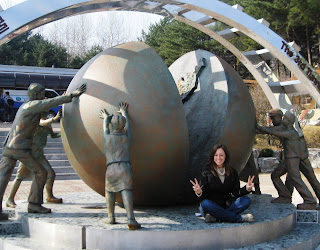 Loved this monument.
Loved this monument. Foreigners from all over the world trying to take pictures. We were told to stay behind a line to take pictures of a NK city to prevent confrontation from the North Korean military.
Foreigners from all over the world trying to take pictures. We were told to stay behind a line to take pictures of a NK city to prevent confrontation from the North Korean military. A North Korean propaganda city. Most buildings don't have ceilings, floors, or backs. They are all for show. In the past, a loud speaker was used to lure people over to that side with messages of a North Korean paradise. If someone crossed onto that side, they would find themselves alone in a bunch a empty buildings, unable to return.
A North Korean propaganda city. Most buildings don't have ceilings, floors, or backs. They are all for show. In the past, a loud speaker was used to lure people over to that side with messages of a North Korean paradise. If someone crossed onto that side, they would find themselves alone in a bunch a empty buildings, unable to return.The DMZ tour was a real awakening for me. It is one thing to hear about the North and South Korean split at the 38th parallel on the news, Internet, and other sources, but it was quite a powerful experience to be up there and see the barbed wire fencing, watch towers, and to feel the seriousness of the situation.
The tour guide on the bus gave us information about the DMZ area outside the base. There is actually a village of around 250 people that live in the DMZ zone where we toured. They have permission to be there because they are decedents of the people that lived there pre-Korean war. Woman can join the village by marring a man that lives there, but a woman living in the DMZ zone would have to leave if she married a man outside the village. People can visit family out of the DMZ zone, but I think it is quite strict and if they move off they can’t move back. The villagers grow crops of rice, ginseng, cabbage, and other products, which are sold for twice as much as regular price. The “DMZ rice” is supposedly healthier and better tasting…hmmm. ;-)
Various forms of wild life, only found in this area, thrive because of the lack of development. Vampire deer, small deer with fangs, are abundant along with many rare birds and plant species. The area is several degrees colder than Jeolanam-do, the southwestern region where I live, but it’s quite pretty.
Our dress code was pretty strict. We had to wear nice pants, no t-shirts or logos, no facial piercing and all tattoos had to be covered. Basically, we just had to look nice, because part of the tour we would be on the North Korean cameras and the military did not want us to be used for propaganda.
During the tour of the base, we were not able to take many pictures and most of the tour we had to stay in line. Our tour guide was a kind US solider from Missouri. He explained how difficult it is for North and South Korea to communicate. Both sides mock each other to make the other side pissed off with announcements or music on their speakers, signs, and other ridiculous things. There is just so much propaganda and hatred. A few horrific incidents have occurred in the past including the ax killing incident in 1976. Two US soldiers were hacked to death by North Korean soldiers near the border when trying to remove a tree blocking the view. Mom works with an individual who served in the military in Korea and helplessly witnessed this event. North Korea did apologize for the murders and now their is a monument on base at Camp Bonifas. (http://en.wikipedia.org/wiki/Axe_Murder_Incident). There are also incidents of people making it over to the other side, sometimes starting gunfire.
A really neat part of the tour was when we were able to walk 240 feet down the "Tunnel of Aggression." This tunnel is over a mile long and was built by North Korea. It is one of four tunnels discovered leading toward Seoul for a surprise attack. Only four tunnels were found, but they believe there are at least ten more undiscovered tunnels. http://en.wikipedia.org/wiki/Third_Tunnel_of_Aggression
Teaching...
 This is my classroom. It's pretty small, but it can fit twelve students comfortably. I have pictures of family and friends on the lower, right hand corner of the marker board, which helps me connect more with my students when they ask questions about back home. The simple frases (May I have a pencil? I am finished. I don't understand. ...) on the left side of the board help my students more effectively communicate with me instead of using crazy hand gestures and yelling "TEACHER, TEACHER, TEACHER" constantly. Raising your hand is not used very much I've noticed, which can be a bit overwhelming sometimes, but it feels so good to hear them practice the English frases on the board.
This is my classroom. It's pretty small, but it can fit twelve students comfortably. I have pictures of family and friends on the lower, right hand corner of the marker board, which helps me connect more with my students when they ask questions about back home. The simple frases (May I have a pencil? I am finished. I don't understand. ...) on the left side of the board help my students more effectively communicate with me instead of using crazy hand gestures and yelling "TEACHER, TEACHER, TEACHER" constantly. Raising your hand is not used very much I've noticed, which can be a bit overwhelming sometimes, but it feels so good to hear them practice the English frases on the board. Giddy Girls
Giddy Girls We made snowflakes with our weather lesson. I was so impressed by them!
We made snowflakes with our weather lesson. I was so impressed by them! 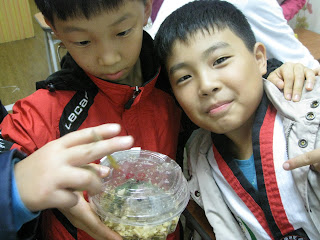 I'm thankful that critters don't bug me, because students tend to bring them to class. Two weeks ago a student had a bat in a plastic container in his backpack. His friends tattle tailed on him and I almost lost it when I saw them playing with the lid. Last week, another student pulled out his new pet hamster! I thought it was pretty cute. Who knows what next week will bring!
I'm thankful that critters don't bug me, because students tend to bring them to class. Two weeks ago a student had a bat in a plastic container in his backpack. His friends tattle tailed on him and I almost lost it when I saw them playing with the lid. Last week, another student pulled out his new pet hamster! I thought it was pretty cute. Who knows what next week will bring!Moonlight Odyssey
"If you stop and listen, there is an ocean of silence. That is the stuff of my work. Where I go for ideas or solice or real texture." Anon
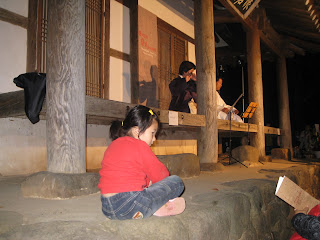 The Gwangju International Center invited foreigners to a beautiful outdoor concert near a temple outside of Gwangju. This concert was unique, because outdoor concerts aren't very common. It was held outdoors to celebrate the autumn season and to praise the full moon. We heard a Daegeum (bamboo) flute, a buk (Korean drum), gayageum (simular to a table harp), geomungo (stringed instrument plucked by a bamboo stick), and a few vocalists. The music was very soft and soothing, almost like rain or soft winds, similar to elements in nature. The men and woman vocalists had deep voices and they sang so passionately. I wish I would have known what they were singing about, and yet, it was fun to let your imagination wonder and make up your own meaning. The concert was wonderful. I appreciated the authentic Korean cultural experience.
The Gwangju International Center invited foreigners to a beautiful outdoor concert near a temple outside of Gwangju. This concert was unique, because outdoor concerts aren't very common. It was held outdoors to celebrate the autumn season and to praise the full moon. We heard a Daegeum (bamboo) flute, a buk (Korean drum), gayageum (simular to a table harp), geomungo (stringed instrument plucked by a bamboo stick), and a few vocalists. The music was very soft and soothing, almost like rain or soft winds, similar to elements in nature. The men and woman vocalists had deep voices and they sang so passionately. I wish I would have known what they were singing about, and yet, it was fun to let your imagination wonder and make up your own meaning. The concert was wonderful. I appreciated the authentic Korean cultural experience.
http://en.wikipedia.org/wiki/Gayageum
http://en.wikipedia.org/wiki/Geomungo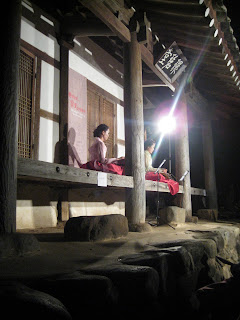
Happy Halloween!

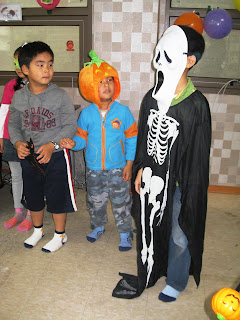

 Halloween is such a great time to dress up and have fun! It is one of my favorite holidays because of the creativity involved. Plus, who doesn't like candy and games!! Halloween isn't celebrated in Korea, but our English school decided to have a party. So on Saturday October 31st, we decorated the library and invited all the students and their friends and siblings. It was so cute, because many of my students introduced me to their siblings and friends. For some of the kids, it was their first Halloween!
Halloween is such a great time to dress up and have fun! It is one of my favorite holidays because of the creativity involved. Plus, who doesn't like candy and games!! Halloween isn't celebrated in Korea, but our English school decided to have a party. So on Saturday October 31st, we decorated the library and invited all the students and their friends and siblings. It was so cute, because many of my students introduced me to their siblings and friends. For some of the kids, it was their first Halloween! I gave them a quick speech about the origin of Halloween and how it is celebrated in America. After that we had several activities including: the best costume (most kids were so shy but they seemed to be proud of their costumes), the mummy contest (teams picked two kids to stand back to back and be wrapped up with toilet paper), pumpkin decorating (everything from apples, oranges, and persimmon were used for this activity :-), and a few other activities. It was such a great time! Plus, it was wonderful to spend time with the kids outside of the classroom and away from bookwork. We laughed, took pictures together, ate candy, and were just plain silly the whole time.
Sunday, November 1, 2009
Glorious Autumn
 "Autumn is a second spring when every leaf is a flower." Albert Camus
"Autumn is a second spring when every leaf is a flower." Albert Camus


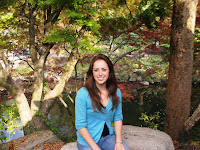
 Mr. and Mrs. Hwang
Mr. and Mrs. Hwang
 Fall season is such a pleasent time here in Korea with the most beautiful colors and perfect temperature. I haven't experienced a true fall season that lasts a few months before coming to Korea. It is such a lovely season and a perfect time to go hiking up in the mountains to wittness the vibrant maple tree colors. Mr. and Mrs. Hwang were kind enough to take me up to Pek Am San for a wonderful hike.
Fall season is such a pleasent time here in Korea with the most beautiful colors and perfect temperature. I haven't experienced a true fall season that lasts a few months before coming to Korea. It is such a lovely season and a perfect time to go hiking up in the mountains to wittness the vibrant maple tree colors. Mr. and Mrs. Hwang were kind enough to take me up to Pek Am San for a wonderful hike.
The Kimchi Festival
 Jang Sa Ik, famous Korean folk singer
Jang Sa Ik, famous Korean folk singer Enthusiastic Opening Ceremony Performers
Enthusiastic Opening Ceremony Performers
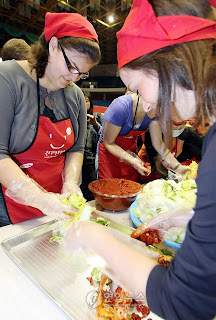 This picture was in the Gwangju newspaper.
This picture was in the Gwangju newspaper.
 This man, dressed in the traditional hanbok, loved Jenni!
This man, dressed in the traditional hanbok, loved Jenni!

 Various dishes of kimchi
Various dishes of kimchi